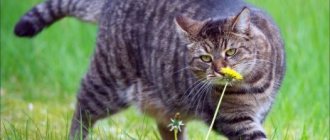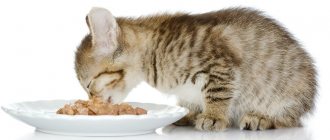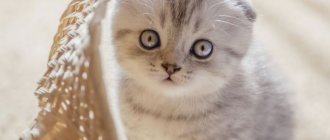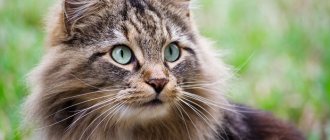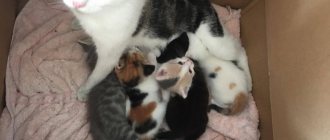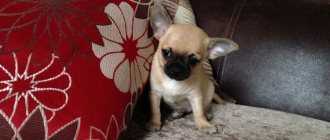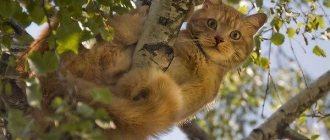How to tell if your cat needs to lose weight
In most cases, obesity develops gradually: if you see your pet every day, you may not notice changes in its appearance or behavior. The main signs indicating the need to lose excess weight include:
- Decreased pet activity. If your cat used to constantly play with a ball or jump on the highest cabinets and shelves, now he prefers to spend most of his time on the sofa or bed. Refusal from active play may be associated with joint pain or the development of shortness of breath, which occurs in an obese animal even with minor exertion.
- External changes. In healthy cats, bony protrusions (ribs, spine) can be easily felt and they have developed dense muscles. With obesity, the animal's waist flattens out, and a hanging belly and fat folds may appear. It is almost impossible to palpate bony landmarks.
- Increased appetite. If you previously fed your furry friend 3-4 times a day, then gradually the number of feedings increases. The animal greedily eats a portion of food and returns for more: there is no satiety due to a distended stomach.
Photo gallery: what obese cats look like
It is more difficult for an overweight cat to move around
Obesity causes sagging of the lower abdomen
Obesity is characterized by a flattened waist or its complete absence
The main factors for gaining excess weight in cats
In most cases, the cause of cat obesity is improper nutrition. The owner overfeeds the pet or adds too much fat and fast carbohydrates to the diet. However, there are other factors that influence excess weight gain:
- sedentary lifestyle: lazy cats are much more prone to obesity;
- castration or sterilization (changes in hormonal levels create the preconditions for gaining excess weight);
- stressful situations (change of residence, appearance of a new pet);
- pregnancy in a cat;
- availability of food in free access;
- abuse of treats;
- consequences of the operation (long-term immobility);
- diseases of the endocrine system requiring medication;
- belonging to some breeds (British cat, Scottish fold, Persian).
Video: veterinarian talks about obesity in animals
Why do pets get fat?
1. Unbalanced feeding
A common cause of obesity in a pet is improper feeding.
Mistakes the owner makes when planning his pet’s diet:
- Overfeeding;
- High calorie diet;
- Mixed type of feeding;
- Harmful treats in the diet;
- Encouraging begging.
2. Passive lifestyle
Many cats constantly stay at home, their activity is limited by the area of the apartment. A pet's sedentary lifestyle and unbalanced feeding lead to weight gain in the pet.
3. Metabolic disorders
Obesity occurs in diseases associated with metabolic disorders. Obesity is often associated with hormonal changes. With a lack of hormones from the pituitary gland, adrenal glands, thyroid and pancreas, fat metabolism is disrupted, which leads to excessive fat deposition in the organs and tissues of the pet.
4. Breed predisposition
Some cat breeds are predisposed to obesity. If you are the owner of a Scottish, Himalayan, British, or Persian cat, pay special attention to the calorie intake and mobility of your pet.
5. Age
Older cats are more prone to obesity than younger cats. With age, animals, like humans, slow down their metabolism and decrease their activity. Excess calories are stored as fat on the sides and stomach.
6. Castration
The energy requirement of castrated animals is significantly reduced. If you continue to feed your cat after castration the same food and in the same quantity, this will lead to weight gain and obesity. After surgery, use a low-calorie, low-fat diet.
How to organize food for overweight cats
When treating obesity in animals, veterinarians are guided by the same principles as nutritionists: the number of calories consumed should be less than their daily expenditure. Such a deficiency creates conditions for burning fatty tissue and allows the pet to quickly get into shape.
To achieve normal body weight, you can use both ready-made food and natural food (at the discretion of the owner).
Basic rules for creating a diet for obese cats:
- Monitor the quality of your food. Use only special food of at least premium class. The economy segment can cause additional health problems in cats. For the same reason, it is recommended to purchase only proven and fresh products when organizing natural nutrition.
- Provide access to clean water. Many cats with a fluid deficiency begin to eat more food to compensate for this deficiency. The water in the bowl should be changed at least twice a day to prevent dust, hair, and food debris from accumulating in it.
- The cat should be fed often, but in small portions. It is better to choose a specific time for this (8, 12, 16, 18, 22, 24 hours). And also stop any begging or food theft by the animal: treats also contain extra calories.
One of my friends’ cat gained a lot of weight over the winter: he gained about 4 extra pounds, which had a negative impact on his health. The owner decided to review his diet and strictly limited his food, and also regularly forced the cat to run after toys. For several months, she tried different types of food, but the furry pet’s weight stubbornly remained the same. The woman was about to seek help from a veterinarian, but one night she caught her husband in the kitchen, together with the cat, finishing a loaf of doctor’s sausage. Such nutrition negated all the daily efforts of the housewife. The husband was given a severe reprimand, and the furry purr was put on a strict diet, after which he still managed to get back into shape.
What is obesity and why is it dangerous for your cat?
Obesity is a disease associated with metabolic disorders. It manifests itself as excessive accumulation of fat in subcutaneous tissue, organs and tissues.
Many domestic cats are overweight. It causes serious health problems and increases the risk of serious diseases: diabetes, heart and vascular diseases, pancreas, liver, urolithiasis, arthritis. Let's talk about the most unpleasant of them in more detail:
- Diabetes mellitus
Excess weight and obesity can trigger the development of diabetes mellitus in a cat. In obese animals, the functioning of the pancreas and the production of the hormone insulin are disrupted. - Diseases of the heart and blood vessels
Fatty deposits in the form of plaques form on the walls of blood vessels, and atherosclerosis develops. The vessels become hard, inelastic, and narrow. Blood access to organs is reduced, and the risk of thrombosis increases. Fatty degeneration of the heart and atherosclerosis are the main causes of the development of cardiovascular failure in an obese animal. - Fatty degeneration of organs
When there is an excess of calories, fat in cats is deposited not only on the ribs and abdomen, but also on the internal organs. This can lead to fatty degeneration of the liver, kidneys, heart, and pancreas. - Urolithiasis
Obese cats are predisposed to the formation of kidney and bladder stones and the development of urolithiasis. - Joint diseases
In fat cats, the load on the musculoskeletal system increases. Joints become inflamed and deformed. Arthritis develops, which can turn into arthrosis. Obese cats move less, lie down more, and have difficulty standing up.
Animals that are overweight are less able to tolerate anesthesia and surgery. Fat cats often experience infertility and complications during childbirth.
What ready-made food should you use to reduce your pet’s weight?
For the safe and slow treatment of obesity, a whole line of special veterinary foods has been developed. Unlike regular nutrition, they are aimed at eliminating excess weight and preventing further weight gain. The main advantages of using such feeds include:
- the ability to choose various flavorings;
- no time spent on cooking;
- long-term storage of feed;
- the effectiveness of such nutrition has been proven by veterinarians;
- the presence of the necessary components in the composition and a strict calculation of caloric content (in most cases, additional administration of vitamins and mineral components is not required);
- using a special feeder with timers to dispense a portion of a certain volume.
Mechanism of action and composition of dietary cat food
Medicinal food differs significantly from regular food. It contains much less fat and carbohydrates, which helps reduce the overall calorie intake. The mechanism of action of such food is to ensure longer saturation, stimulation of the gastrointestinal tract and normalization of metabolic processes in the cat’s body. This is achieved due to a certain balance of nutrients. The low-calorie food contains the following components:
- Plant fiber (beet pulp, bran, chopped oats, corn flour, brown rice, spinach). It acts as a natural scrub for the intestines, improving intestinal motility and stimulating timely bowel movements.
- Animal protein (processed beef, fish, poultry). Its amount is several times higher than the level of fats and carbohydrates, which allows you to burn excess fat without losing muscle mass.
- L-carnitine, taurine, mineral complexes and vitamins B, C, A, E. These components accelerate metabolic processes and restore the body’s need for various macro and microelements.
Is it possible to use diet food without consulting a specialist?
You should only select specialized food yourself if you have the appropriate education. When selecting a diet for obese cats, the doctor must take into account the breed of the animal, its weight, and the individual characteristics of the body. This allows you to determine the required calorie content, calculate the number of feedings and the volume of one serving. Before prescribing certain foods, blood tests should be taken to identify possible damage to the liver and digestive tract.
Contraindications to the prescription of dietary nutrition are pregnancy, lactation and age under one year.
How long should you feed your cat medicated food?
In order not to harm your pet’s health, it is necessary to reduce its body weight gradually (no more than 0.5–1% per week). On average, low-calorie food is prescribed for a period of 6 months to a year, after which the cat’s condition is monitored. In some cases (old age, upcoming surgery, certain breeds), the animal must adhere to such a diet throughout its life. This provides reliable prevention of further progression of obesity and increases life expectancy by several years.
It is also worth transitioning your cat to regular food gradually. One of my colleagues had a Persian cat who ate only dietary food for a year, which quenched his appetite and helped him stay in shape. The owner decided that the result had been achieved: the pet could be switched to its usual diet, after which it began to buy regular economy-class food. This diet is characterized by insufficient balance and a minimal amount of fiber. As a result, due to a lack of nutrients, the cat began to regularly steal food from the table, which caused stomach illness. The owners turned to the veterinarian, who selected the best food for them in terms of price and composition.
Is it possible to mix diet food with regular food?
Veterinarians do not recommend combining two foods with each other, since they have completely different energy values and composition. This leads to a significant decrease in the effect of dietary nutrition and the process of treating obesity slows down. But for many cats, a sudden change in diet can become very stressful: in this case, it is permissible to combine two foods with each other. Veterinarians recommend switching the animal to a new food within a week, gradually replacing the old one.
Changing food will be painless if the new food is introduced gradually
Causes of obesity in cats
Most cats get fat for a number of known reasons that are overlooked due to everyday life. A pet may overeat only because it is more convenient for you to leave a full bowl of dry food and be sure that you will not forget to feed the cat in the evening.
Prevention of parasites is carried out once every 3-4 months, but due to workload or problems at work, you may forget about it... and the presence of worms is one of the reasons for overeating, loss of muscle mass, but gain of fat mass .
Due to financial difficulties, you could switch your pet to cheaper dry food, the cat is happy and your wallet is not empty, but have you read the composition of this food? Is it healthy or is it made up of carbohydrates and some undefined type of “protein”? Poor quality dry food is a very common cause of obesity and more!
If fed improperly, a cat may develop metabolic disorders, thyroid and pancreatic glands, liver, digestive system and other ailments. Naturally, all these diseases may not be related to feeding, but the risk of their occurrence increases sharply if the pet regularly receives low-quality food.
Note! Any home-cooked food is better than cheap food, at least you know what goes into your pet's bowl.
Veterinarians still argue whether obesity or endocrine system disorders come to the fore. Just 10 years ago it was believed that if a cat gains weight, then it is guaranteed to have problems with hormones. Today, there is a lot of research showing that hormones and weight are tightly linked and that obesity can be the root cause of hormonal imbalances.
Obesity in cats is a diagnosis , that is, a disease, so in veterinary medicine it is customary to distinguish such a thing as excess weight - that is, extra pounds are the consequences of poor nutrition, low activity or health problems. It is worth understanding that excess weight today means obesity (that is, a disease) in 1–1.5 years.
The most common reasons for gaining excess weight are related to overeating. The desire to constantly eat, the desire to eat despite satiety or lack thereof also has reasons:
- Competition or greed - if there are several animals living in the house.
- Boredom - the cat does not receive attention, does not have the opportunity to have fun, and the pet’s daily routine consists of sleep and walks to the bowl.
- Imposition - every time a cat passes by a bowl, she sees a pile of food, she does not know what a feeding schedule is and is used to eating literally around the clock. By the way, such a situation is very dangerous if the cat has a dulled sense of satiety. Some four-legged animals are voracious due to breed characteristics, psychological trauma or heredity.
The process of overeating may not depend on the cat at all. Very often the owner does not know what the optimal daily intake is for the pet . When kept on industrial food, the cat receives a pile of granules per eye. Moreover, if you examine a pack of food, you will definitely find a table that will indicate the daily requirements in grams. High-quality industrial feeds are fully balanced and fortified, that is, eating too much granules leads to a completely normal consequence - weight gain and obesity.
A cat’s diet, or more precisely, its preferences, are formed in childhood - this is obvious, but there is one bottleneck. A kitten is a child, its whims are satisfied, and its whims are touched. The kitten is growing quickly, which means she should get more food...partially true. However, for the correct formation of a “nutritional culture” of food, the kitten must receive a lot of food in small portions . Simply put, having become accustomed to filling its belly in childhood, a grown pet will feel uncomfortable if it is not full to the same extent.
Note! Some breeds are prone to gaining excess weight and gluttony, regardless of compliance with the rules of keeping and feeding. You can find out about such features of your pet in advance from the breeder.
If you have adopted an adult cat and it tends to overeat, you need to deal with the problem differently. Firstly, develop a nutrition schedule and stick to it, and secondly, evaluate all possible flaws in the preparation of the diet. Since animal metabolism is very individual, the ideal diet can only be found through trial and error. If the situation is urgent, the four-legged glutton is selected with dietary food for cats with obesity or a tendency to gain weight.
Overeating can be directly related to the owner, or more precisely, the family in which the cat lives. As you know, begging is a habit that lives as long as it is encouraged. If your ward has a habit of begging for treats from the table, most likely, he eats an extra (and not a small) portion of food only due to the generosity of your family. The owner thinks, what could happen from a piece of sausage? Now think about how much forbidden food your ward receives if every family member treats him during the meal?
In the canons of dog education there is an ironclad rule - the pet does not enter the kitchen (dining room) when the owner or his family is eating. The same rule should be applied to cats, because if you allow your pet to watch you devour a sandwich with appetite and not share, you are literally inhumane. It is known that the feeling of hunger increases if you watch someone eat. There is even a technique that allows you to stimulate animals to eat and it is “tied” to eating food in front of the pet. If you want to raise your cat properly and not have problems with begging or stealing from the table, you only have two options:
- Do not allow your pet to be near you while eating.
- Synchronize the food intake of four-legged and two-legged family members.
One more thing about a piece of sausage and its harmlessness. There is a list of prohibited products, yes, it is ambiguous and some experts question a number of statements. However, the harm caused by salted, smoked, spicy, floury foods and bones is irrefutable . If you don't know how natural a product is, think about whether a wild cat could get it.
Note! “Favorite treats” are milk and fish; these are absolutely not natural products for a cat’s diet.
Of course, poor nutrition is not the only cause of obesity in cats. Most four-legged animals love to play, but may not know it. If you got a cat as a piece of furniture, played with it as a child, and as soon as it grew up, began to ignore it, then its lifestyle will be appropriate.
Unlike dogs, healthy cats sleep or snooze up to 80% of their lives, a rate that varies by breed and temperament, but is still impressive. During those 20-30% of the time that is not spent sleeping, the cat needs to have time to eat, go to the toilet and clean up... where can you find time for games. Have you ever watched your cat being possessed by something for 2-3 minutes that makes your pet run, jump, scream, and then immediately calm down? These are the very minutes that a pet can allocate for activity and she spends them as efficiently as possible.
The good news is that sleep and napping are two different things. You cannot interfere with the duration of sleep, it is dangerous to health, but replacing a nap with an exciting game is not only possible, but also necessary.
A huge number of inexperienced owners believe that the pet will gain weight after sterilization . These arguments are completely wrong if you feed the animal correctly and devote time to it. If the cat serves as an interior changer, he will gain weight both after castration and without this procedure, however, after the intervention, changes will occur much faster. The reason is that after six months or a little faster, the pet’s hormonal levels will calm down, the need to search for the pet will disappear and unspent energy will need to be redirected.
A cat that receives attention and has the opportunity to play, run or spend its leisure time in other active ways will not gain excess weight. A pet that is bored for days will find a solution in gluttony. Another apogee of owners’ concerns concerns feeding oral contraceptives to cats. You shouldn’t hope that hormonal pills won’t lead to weight gain, they will! The problem is that, against the background of obesity, every ninth cat is diagnosed with serious health problems, and every sixth has neoplasms or oncology.
Table: comparative characteristics of dietary feeds of various brands
| Name of food | Class | View | Flavors | Peculiarities | Price |
| Eukanuba Adult Sterilized Weight Control Chicken | Superpremium | Dry | Chicken | Designed for sterilized and neutered male cats |
|
| Hill's Prescription Diet Metabolic Weight Management | Superpremium | Dry | Chicken | Allows you to maintain optimal weight |
|
| Hill's Prescription Diet Metabolic + Urinary Weight Care | Superpremium | Dry | Chicken, turkey | Also used for cats with urinary tract diseases |
|
| Hill's Prescription Diet i/d Digestive Care (jelly) | Superpremium | Wet | Chicken | Helps maintain a healthy digestive tract |
|
| Hill's Prescription Diet w/d Digestive/Weight Management | Superpremium | Dry | Chicken | Helps normalize weight in diabetic cats |
|
| Hill's Prescription Diet w/d Digestive/Weight Management (jelly) | Superpremium | Wet | Chicken | Better absorbed by the pet's stomach |
|
| Royal Canin Satiety Weight Management SAT34 | Superpremium | Dry | Chicken, poultry | Can be used for diabetes and urolithiasis |
|
| Royal Canin Neutered Adult Maintenance | Superpremium | Wet | Chicken, pork, poultry, liver | Suitable for sterilized animals in the postoperative period |
|
| Pro Plan Veterinary Diets Feline OM Obesity (Overweight) Management dry | Premium | Dry | Chicken, poultry | Used for adult cats |
|
| Farmina Vet Life Natural Diet Cat Obesity | Premium | Dry | Chicken, pork, poultry | Prevents muscle loss | 2 kg - 1709 rub. |
| Royal Canin Satiety Weight Management (jelly) | Superpremium | Wet | Chicken | Suitable for pets with diabetes |
|
| Purina Pro Plan Veterinary Diets OM pouches | Superpremium | Wet | Chicken | Helps maintain weight |
|
| Happy Cat Adipositas | Superpremium | Dry | Chicken, poultry | Also used for cats with liver disease |
|
| Brit VDC Obesity | Superpremium | Dry | Chicken | Suitable for British cats, grain free | 2 kg - 1240 rub. |
| Forza10 Active Line | Superpremium | Dry | Fish | Consists of heart-shaped granules | 454 g - 470 rub. |
| Enova Breeder Cat Light Indoor | Superpremium | Dry | Chicken, rice | Can be used to feed cats over 7 years of age | 10 kg - 6300 rub. |
| Bosch Sanabelle Light for cats prone to obesity | Superpremium | Dry | Bird | Provides quick satiety due to the large amount of dietary fiber | 2 kg - 1300 rub. |
| Barking Heads Adult Fat Cat Slim | Holistic | Dry | Chicken, salmon | Suitable for pets with sensitive stomachs |
|
| 1st Choice Weight Control | Superpremium | Dry | Chicken | Designed for adult animals | 5.5 kg - 2600 rub. |
Photo gallery: examples of dietary foods
Hill's Prescription Diet i/d Digestive Care stimulates the stomach and intestines Purina Pro Plan Veterinary Diets OM pouches improves digestion Royal Canin Satiety Weight Management comes in jelly form Forza10 Active Line has an original heart-shaped granule shape Happy Cat Adipositas helps reduce weight in cats with disease liver Hill's Prescription Diet w/d Digestive/Weight Management is used for cats with diabetes Hill's Prescription Diet Metabolic Weight Management helps maintain proper body weight Pro Plan Veterinary Diets Feline OM Obesity allows you to quickly lose excess weight
Feeding Obese Cats Natural Products
If your animal has gained excess weight on a natural diet, you should also reconsider its diet. Don't forget that a healthy adult cat's diet should include proteins and fats of animal origin. You shouldn’t suddenly switch your furry pet to plant foods or greatly reduce portion sizes: this will only provoke unnecessary stress. Veterinarians recommend using the following products to feed overweight cats:
- Meat, offal and fish contain the required amount of protein and essential amino acids. Lean beef, rabbit, chicken or turkey are suitable for dietary nutrition. Of the by-products, preference should be given to hearts and liver. Meat should be served boiled or fresh frozen to destroy helminths. For dietary nutrition, steamed sea fish (trout, salmon) is mainly used.
- Milk based products. Kefir, cottage cheese, fermented baked milk, goat cheese, bifidok are sources of calcium and easily digestible protein, so they must be included in the cat’s diet. Please note that their fat content should not exceed 2–5%.
- Porridge and cereals. The fiber they contain provides satiety and acts as a natural scrub for the intestines, removing toxins. Cereals that are healthy for cats include rolled oats, brown rice, and millet. They need to be boiled in water or chicken broth.
- Greens and vegetables. They are used as an additive to cereals or meat: they should be boiled and ground in a blender. The best foods for feeding cats are spinach, celery, zucchini, squash, green beans, carrots, broccoli, and cauliflower.
Photo gallery: healthy foods for pets
By-products contain the required amount of protein
Dairy products are rich in calcium
Vegetables are the best source of vitamins and minerals
It is harmful to feed cats from the home table: our food contains a large amount of salt and various additives that negatively affect their health. Such a diet contributes to the development of obesity and other dangerous diseases. Veterinarians strictly prohibit giving overweight cats the following foods:
- sausage, frankfurters, small sausages;
- semi-finished products (cutlets, zrazy, dumplings);
- butter;
- chicken skin and fat from meat;
- bones;
- processed cheese;
- ice cream;
- sweet yoghurts and curds.
Essential vitamins and mineral complexes
When organizing natural nutrition, it is quite difficult to take into account the cats’ need for vitamins and minerals when preparing a diet. Often, in their absence, metabolic processes slow down and various diseases can develop. To avoid such complications, you need to contact your veterinarian to select the optimal complex of vitamins and mineral components. They usually come in the form of pleasant-smelling tablets that can be crushed finely and added to your cat's food.
Give preference to proven products from a veterinary pharmacy. For example, adding crushed shells to an animal’s diet is not welcomed by veterinarians, as it can lead to digestive disorders.
The most popular vitamins and mineral complexes for cats:
- Beaphar Top 10 (contains taurine);
- Canina Cat-Vitamin Tabs;
- VetExpert VetAminex;
- Doctor Zoo "Health and Beauty";
- Dreamies pillows with chicken and taurine;
- Phytomines for castrated cats;
- Gimpet Schnurries (to normalize metabolism);
- Nutri-Vet Wild Alaskan Salmon Oil.
Please note that vitamins should be stored out of the reach of cats. Once, on the advice of a veterinarian, I bought vitamins for my cat, which he liked. I accidentally left the box on the table, which my pet took advantage of. He ate about half of the tablets, which did not affect his health in any way, but led to a complete aversion to them. The cat completely refused vitamins for several months.
Photo gallery: vitamins and mineral complexes
Canina Cat-Vitamin Tabs - multivitamin complex
Doctor Zoo is a domestic brand
Phytomines are used for castrated cats
